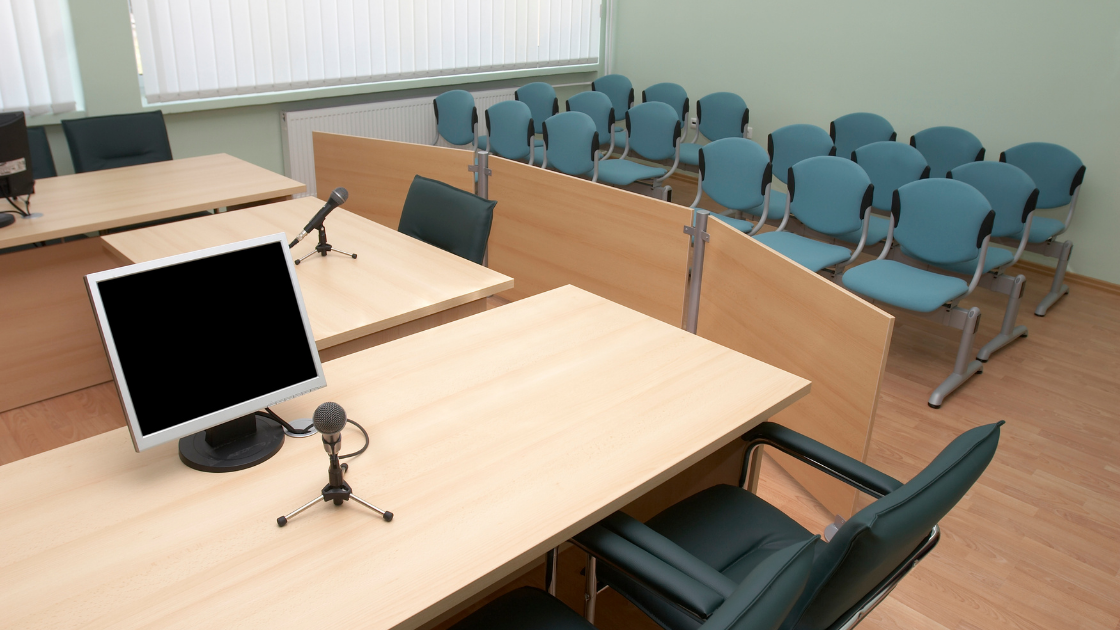Since the onslaught of the pandemic, courts have struggled to understand its impact on modern courthouse planning. Because we are court planners, in the early period of the pandemic we were constantly asked about the emerging trends we were seeing in courthouse design as a result of the pandemic. At that time, it was a tough question to answer as courts were trying all sorts of things to manage their workload.
During the last three years, we have written several blogs on how the pandemic has influenced court operations. But much of the discussion has centered around recommendations that responded to the immediate crisis, or ideas that had not been completely tested out. Now that many workplace restrictions are being lifted and courts are returning to full operations, the question has become very real. Our court clients want spaces that are responsive to the trends that may continue after the pandemic.
Two solutions that seem to have risen to the top are 1) hybrid courtrooms - flexible adjudication spaces that incorporate more robust technology, and 2) “Zoom rooms” - spaces the community can use to access remote hearings. Some courts are receptive to these changes. However, for many courts, there is still skepticism about whether these trends will continue. And if they do continue, how will these changes be managed on a permanent basis? I believe now is an important time to bring to light some of the concerns we have heard from court administrators regarding each solution.
Hybrid Courtroom
What is a hybrid courtroom? A hybrid courtroom functions like a small hearing room. While several sizes and types of hybrid courtrooms are being discussed in courthouse planning circles, a hybrid courtroom is generally smaller than a traditional courtroom and designed to accommodate a limited number of in-person participants as well as other participants who access the proceedings remotely. Some examples of a hybrid courtroom include:
- A room that accommodates only the judge and one or two additional staff
- A room that accommodates the judge, court staff, and one of the parties, while the other party participates remotely
- A room that accommodates the judge, court staff, and both parties, while the public participates remotely
- A room where there is the option for either the judge or one or both parties to participate remotely with limited public seating
A hybrid courtroom often has movable furniture so that it can be configured for different types of functions. In some cases, a hybrid courtroom is a traditional courtroom that can be divided into smaller rooms, or two traditional courtrooms that could be combined to provide a very large courtroom to accommodate social distancing should the need arise.
Why have hybrid courtrooms emerged? The pandemic has changed the model for how court proceedings are conducted at almost every level of the judicial system. In most instances, courts have realized that remote hearings can be an efficient way of doing business for certain types of proceedings. For example, small claims hearings, civil motor vehicle infractions hearings, mental health hearings and evaluations, and some civil and criminal pre-trial hearings can likely remain virtual, with some exceptions.
We have found that most courts are willing to take a fresh look at their operations and specify the types of hearings that should remain virtual. Their confidence in holding remote proceedings is bolstered by their experience operating in this manner over the last three years.
By conducting more proceedings virtually, the need for larger traditional courtrooms can be reduced. Although trial courtrooms and large arraignment courtrooms aren’t likely to go away altogether, courts are receptive to providing a mix that includes smaller, multi-purpose courtrooms that incorporate the proper technology.

What are the challenges with hybrid courtrooms? The biggest challenge in planning for hybrid courtrooms is determining the right mix of traditional vs. hybrid courtrooms for a particular courthouse. Each court is unique, and at this time there are not enough metrics on courtroom utilization to suggest an ideal ratio. The backlog of cases brought about by the pandemic has also made the situation a bit murkier as courts are unsure what the status quo will look like moving forward.
Another challenge is selecting suitable furniture for hybrid courtrooms, particularly if the furniture is going to be movable. While it needs to be lightweight and flexible, it also needs to express the level of dignity that is required in a courtroom. Additionally, technology needs to be robust and thoughtfully integrated into the design. It will also be necessary to establish protocols for scheduling the use of the spaces and for clearly defining who is responsible for rearranging the space between uses.
Although there are certainly challenges that come with incorporating hybrid courtrooms, I believe they provide the flexibility the court has come to desire and should be considered a viable option for any courthouse construction or renovation project.
“Zoom Room”
What is a “Zoom room?” A Zoom room is a court-provided space in the courthouse that is set up for the public or litigants to participate in court proceedings using remote access technologies. These gathering spaces have affectionately come to be known as “Zoom rooms” after the videoconferencing giant Zoom, and continue to be very popular as the scheduling of remote hearings continues to become a more regular practice. Zoom rooms can serve as an alternative when courtroom space is limited or when there are other reasons to conduct remote proceedings.
Why have Zoom rooms emerged? Remote proceedings became a key part of how courts managed their workload during the pandemic. Often times judges were restricted from traveling to each courthouse, courts were forced to consolidate hearing schedules between different locations due to facility closures, or social distancing permitted only a limited number of participants in the courtroom. To make participating in the proceedings possible, litigants and/or the public needed access to a computer. It became clear early on that not everyone has access to a computer, a steady internet connection, and/or reliable software. As a result, courts had to provide a space that was equipped with internet access so that litigants could come to the courthouse and use the court-provided computer to participate in the proceeding.
Sometimes the proceedings being accessed via the Zoom room were held in the courthouse, but the number of participants was limited because of social distancing. In most cases, the participants attended the hearing remotely from different locations – a practice that will most likely continue for many types of proceedings.
What are the challenges? Most courts we speak with agree that Zoom rooms will be necessary moving forward – particularly because it is likely that at least some hearings will remain virtual. The challenge for the court is staffing and managing this operation. In most instances, for this to be a permanent fixture in a courthouse, additional staff will be required to manage the schedule, maintain the equipment, and respond to the users’ needs. It has been suggested that existing clerk’s office staff should meet this need. However, court administrators are concerned that many clerk’s offices are already understaffed and underfunded, and that the existing staff lack the expertise to manage such an operation.
This challenge becomes particularly concerning for state and local courts. Funding sources for IT equipment and staffing are often provided by the state and are separate from local funds. Unless there is a statewide initiative specifically dedicated to providing the staff and equipment for the Zoom rooms, local courts may be unfairly burdened by having to support this function on their own. For one of our most recent courthouse planning efforts, the state has recognized this need and is currently working with the planning team to implement Zoom rooms as part of their design guide. The state has also been working with the local courts to provide a funding solution to ensure the success of this important community service.
Beyond the Pandemic
Needless to say, there is still much to learn about the lingering effects of the pandemic on the delivery of court services. However, one thing is certain: courts now recognize the need to be proactive in space planning. The prior reluctance of many jurisdictions to change their business model or to incorporate progressive space changes left many courts scrambling to implement those services during the pandemic.
As court planners, we will continue to monitor the situation and bring the best practices that have emerged from this pandemic to our upcoming courthouse projects. As we listen to our clients and learn what programs and space changes have been effective, we also learn about the obstacles that still need to be overcome. These lessons learned can help shape the future administration of justice in a way that protects the integrity of the justice system while remaining responsive and flexible to changing needs over time.
_______________________________________________





.jpg)
.jpg)
.jpg)
.jpg)
.jpg)
.jpg)


-1.jpg)
.jpg)
.jpg)

